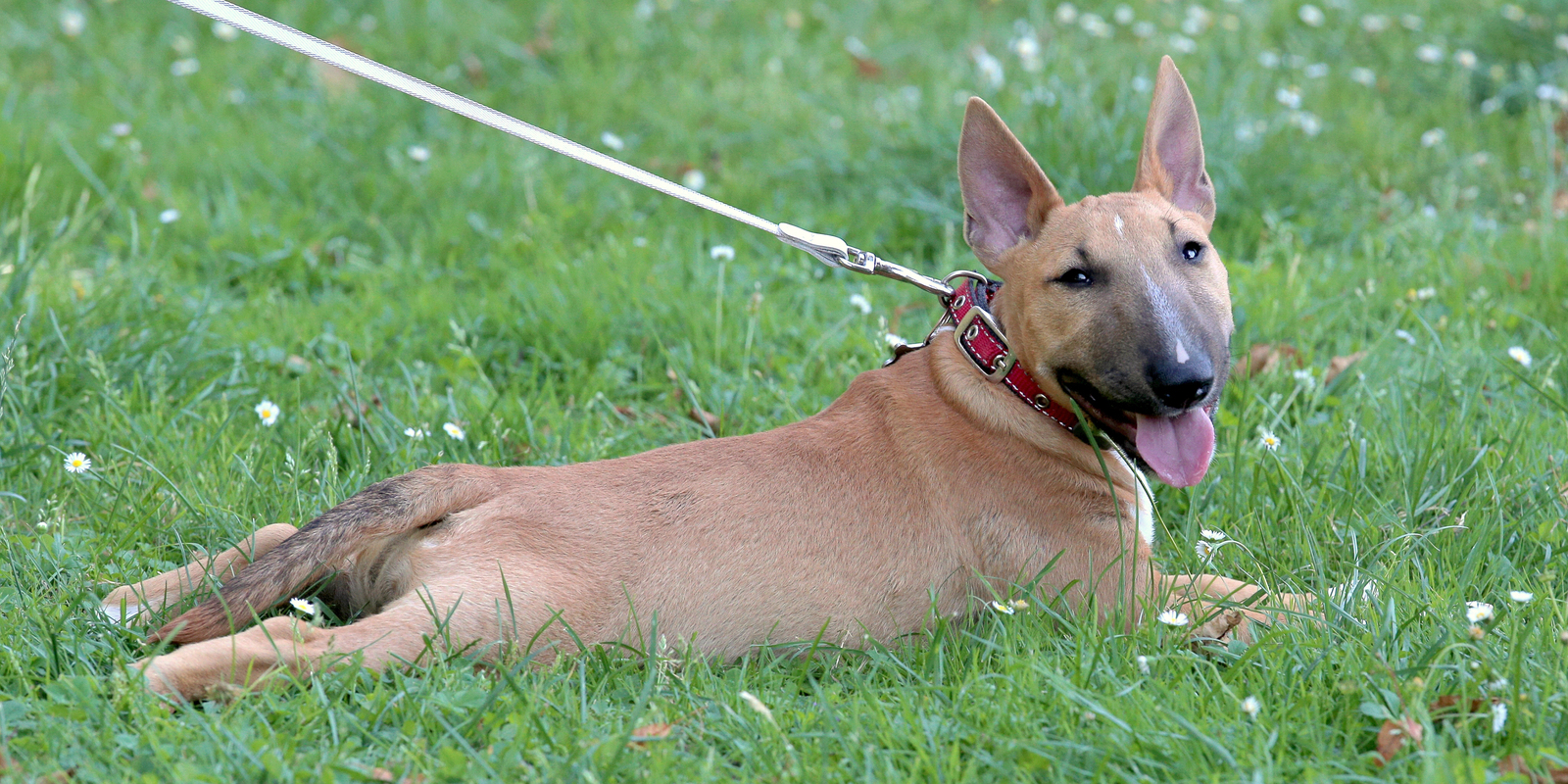The Miniature Bull Terrier and Staffordshire Bull Terrier have deep roots in England. Both breeds share a common ancestor in the Bull and Terrier, but their development took different paths. Let’s explore these two dog breeds.
If you’re still on the market to buy a Miniature Bull or Staffordshire Bull Terrier, PuppySpot currently offers a $300 discount using the code PUPPY300, just click the banner below!
Physical Characteristics
Miniature Bull Terriers and Staffordshire Bull Terriers have distinct physical traits that set them apart. Both breeds have muscular builds, but they differ in size, shape, and certain features.
Size and Weight Comparison
- Miniature Bull Terriers are smaller than Staffordshire Bull Terriers. You’ll find that Miniature Bull Terriers typically stand 10-14 inches tall and weigh 20-35 pounds.
- Staffordshire Bull Terriers are larger, usually 14-16 inches in height and weighing 24-38 pounds.
- The size difference is noticeable when you see these breeds side by side. Miniature Bull Terriers have a more compact build, while Staffies have a stockier appearance.
Distinctive Features
- The most striking feature of Miniature Bull Terriers is their egg-shaped head. This unique skull shape gives them a distinctive profile that’s easy to spot.
- Staffordshire Bull Terriers have a broader, more rounded head shape. Their ears are typically rose or half-pricked, unlike the upright ears of Miniature Bull Terriers.
- Both breeds have short, smooth coats that are easy to maintain. Miniature Bull Terriers often come in white, but can also be found in other colors. Staffordshire Bull Terriers have a wider variety of coat colors and patterns.

Personality and Temperament
Miniature Bull Terriers and Staffordshire Bull Terriers have distinct personalities. While both breeds are friendly and loyal, they differ in energy levels and sensitivity.
Temperament of Miniature Bull Terriers
Miniature Bull Terriers are playful and energetic. You’ll find them to be:
- Courageous and confident
- Intelligent and sometimes stubborn
- Affectionate with family members
These dogs have a high energy level. They need regular exercise and mental stimulation to stay happy. Miniature Bull Terriers can be sensitive to their owner’s moods. They may not always get along with other pets due to their strong prey drive.
Temperament of Staffordshire Bull Terriers
Staffordshire Bull Terriers are known for their:
- Gentle and patient nature with children
- Strong loyalty to their family
- Friendly disposition towards strangers
These dogs are intelligent and eager to please. They have a moderate energy level and enjoy playtime with their owners. Staffies are generally less prone to wandering than Miniature Bull Terriers. Staffordshire Bull Terriers are brave and protective of their families. They may be wary of other dogs, but proper socialization can help. These dogs thrive on human companionship and don’t like being left alone for long periods.
Health and Lifespan
Both Miniature Bull Terriers and Staffordshire Bull Terriers face some similar health issues. Their lifespans differ slightly, with one breed tending to live a bit longer than the other.
Common Health Issues in Both Breeds
- Dental disease is a concern for both breeds. You should brush your dog’s teeth regularly to prevent problems.
- Skin allergies can affect both Miniature Bull Terriers and Staffordshire Bull Terriers. Watch for excessive scratching or redness.
- Both breeds can develop eye problems that may lead to blindness if not treated. Regular vet check-ups are important.
- Miniature Bull Terriers are prone to being overweight. Keep an eye on their diet and exercise.
- Staffordshire Bull Terriers may develop hip dysplasia. This can cause pain and limping.
Average Lifespan
- Miniature Bull Terriers typically live 10-14 years. With proper care, they can reach the upper end of this range.
- Staffordshire Bull Terriers have a slightly longer average lifespan. They often live 12-14 years.
- Regular vet visits and a healthy lifestyle can help both breeds live longer. This includes a balanced diet, exercise, and dental care.
- Keep in mind that individual dogs may live shorter or longer than these averages. Genetics and care play big roles in a dog’s lifespan.
Breed Care and Management
Both Miniature Bull Terriers and Staffordshire Bull Terriers need regular care and attention. They have different grooming needs and training requirements.
Grooming Needs
- Miniature Bull Terriers have short, smooth coats that shed moderately. You should brush them weekly to remove loose hair and keep their coat shiny.
- Staffordshire Bull Terriers also have short coats but shed less. A quick brush once a week is usually enough.
- Both breeds need regular nail trims and ear cleaning. Bathe them only when necessary to avoid drying out their skin.
- Dental care is important for both breeds. Brush their teeth several times a week to prevent dental issues.
Training and Socialization
- Miniature Bull Terriers can be stubborn. You need to start training early and be consistent. Use positive reinforcement methods to keep them engaged.
- Staffordshire Bull Terriers are eager to please and typically easier to train. They respond well to praise and rewards.
- Both breeds need early socialization. Expose them to different people, animals, and situations as puppies.
- Mental stimulation is crucial for both breeds. Provide puzzle toys and regular training sessions to keep their minds active.
- Exercise is important for both breeds. Daily walks and playtime will help burn energy and prevent behavior problems.
Suitability for Families
Both breeds can make great family pets, but they have different traits that affect how well they fit into family life. Their interactions with children and adaptability to various living situations are key factors to consider.
Interaction with Children
- Staffordshire Bull Terriers are known for being excellent with kids. They’re patient, gentle, and protective of children in their family. Staffies love to play and can keep up with active kids.
- Miniature Bull Terriers are also good with children, but they need more supervision. Their playful nature can sometimes be too rough for very young kids. You should teach your children how to interact safely with these energetic dogs.
- Both breeds need early socialization and training to ensure they behave well around kids. Always watch young children when they’re with any dog, no matter the breed.
Adaptability to Living Environments
- Staffordshire Bull Terriers can adapt well to different living spaces. They’re okay in apartments if you give them enough exercise. Staffies don’t like being left alone for long periods.
- Miniature Bull Terriers need more space and exercise. They’re not ideal for small apartments. These dogs have lots of energy and need room to play and run.
- Both breeds enjoy outdoor activities and need daily walks. Miniature Bull Terriers require more exercise than Staffies. If you’re an active family who likes to spend time outdoors, either breed could be a good fit.
- For first-time dog owners, Staffordshire Bull Terriers might be easier to handle. They’re generally calmer and more adaptable than Miniature Bull Terriers.

Training Challenges and Exercise Requirements
Both Miniature Bull Terriers and Staffordshire Bull Terriers need plenty of exercise and mental stimulation. These breeds have high energy levels and strong prey drives that require careful management during training.
Managing Energy Levels
- Miniature Bull Terriers and Staffordshire Bull Terriers are active, playful dogs that need daily exercise. You should plan for at least 60 minutes of activity per day for each breed.
- Walks, runs, and playing fetch are great ways to burn energy. Without enough exercise, both breeds may develop destructive behaviors.
- Staffies tend to have slightly higher energy levels. You may need to provide extra playtime or longer walks to keep them satisfied.
- Mental stimulation is also key. Puzzle toys and training games can help tire them out mentally.
Training and Intellect
- Staffordshire Bull Terriers are generally easier to train than Miniature Bull Terriers. Staffies are eager to please and respond well to positive reinforcement.
- Miniature Bull Terriers can be more stubborn. You’ll need patience and consistency when training them.
- Both breeds are intelligent, but may get bored with repetitive tasks. Keep training sessions short and fun.
- Early socialization is crucial for both breeds to manage their strong prey drives. Teach them to focus on you instead of chasing small animals.
- Be aware that both breeds can develop separation anxiety if left alone too long. Crate training and gradually increasing alone time can help.
Breed-Specific Behavior Traits
Miniature Bull Terriers and Staffordshire Bull Terriers have unique traits that shape their behavior. These breeds differ in their social needs and protective instincts.
Social Needs and Playfulness
- Miniature Bull Terriers are very playful and energetic. They love to be around people and need lots of attention. You’ll find them always ready for a game or a fun activity. These dogs can be stubborn at times, but they’re also quite affectionate.
- Staffordshire Bull Terriers are also very social. They’re known for their love of people and strong desire to be part of the family. These dogs are great with kids and often called “nanny dogs.” They have a high energy level and need plenty of exercise and playtime.
- Both breeds are loyal and friendly. They do well with regular social interaction and playtime with their owners.
Territorial and Protective Instincts
- Miniature Bull Terriers have a moderate prey drive. They may chase small animals if not trained early. These dogs can be good watchdogs but aren’t typically aggressive.
- Staffordshire Bull Terriers are more protective. They’re known for their strong loyalty to their family. This breed can make excellent guard dogs. They may be wary of strangers but aren’t usually aggressive without reason.
- Both breeds need early socialization. This helps them get along well with other pets and people. Neither breed tends to bark excessively, but they’ll alert you to potential threats.




